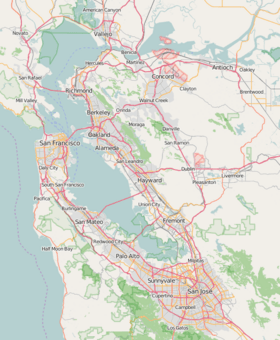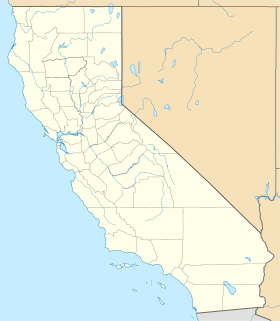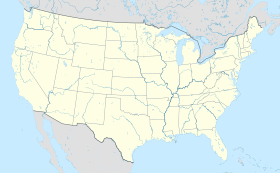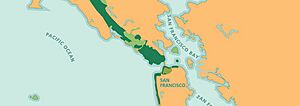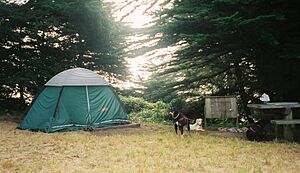Golden Gate National Recreation Area facts for kids
Quick facts for kids Golden Gate National Recreation Area |
|
|---|---|
|
IUCN Category V (Protected Landscape/Seascape)
|
|
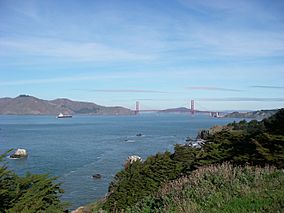
View of the Golden Gate from Lands End
|
|
| Location | San Francisco Bay Area, California, United States |
| Nearest city | San Francisco, California |
| Area | 82,027 acres (331.95 km2) |
| Established | October 27, 1972 |
| Visitors | 15,002,227 (in 2019) |
| Governing body | National Park Service |
| Website | Golden Gate National Recreation Area |
The Golden Gate National Recreation Area (GGNRA) is a huge park system around the San Francisco Bay Area in California. It protects over 82,000 acres of important natural and historical places. Much of this land used to belong to the United States Army.
The GGNRA is managed by the National Park Service. It is the most visited national park area in the United States, with more than 15 million visitors each year! It's also one of the biggest city parks in the world. It's about two and a half times larger than the entire city of San Francisco.
This park isn't just one big piece of land. It's a group of different areas that stretch from southern San Mateo County to northern Marin County. It also includes several spots within San Francisco itself.
The GGNRA is very diverse. It has famous places like Muir Woods National Monument, Alcatraz, and the Presidio of San Francisco. The park is home to over 3,000 types of plants and animals. It also has 59 miles (95 km) of bay and ocean shoreline. You can find old military forts here that show centuries of California history. These range from Spanish times to Cold War-era missile sites.
Exploring the Golden Gate National Recreation Area
The GGNRA is made up of many different sites. These are spread across Marin County, San Francisco, and San Mateo County. Each area offers unique things to see and do.
Marin County Highlights
Marin County is north of San Francisco. It has many beautiful natural areas within the GGNRA.
- Fort Baker - This was once an Army base. It sits on the northern side of the Golden Gate.
- Headlands Center for the Arts - This place uses old military buildings. Artists live and work here. They offer public programs like shows and talks.
- Marin Headlands - This is a hilly area at the southern tip of Marin County. It includes places like The Marine Mammal Center, Rodeo Lagoon, and Rodeo Beach.
- Muir Woods National Monument - This forest is filled with giant Coast Redwood trees. You can also see Coast Douglas-fir and Bigleaf Maple trees here.
- Oakwood Valley - This valley has the largest untouched forest of Coast Live Oak and California bay trees in the GGNRA.
- Olema Valley - This area has 10 miles (16 km) of grasslands and forests. It stretches from Tomales Bay to Bolinas Lagoon.
- Point Bonita Lighthouse - This is an active lighthouse. The United States Coast Guard still takes care of it.
- Stinson Beach - A popular beach north of San Francisco.
- Muir Beach Overlook - This spot used to be an Army base. Now it offers amazing views of the Pacific Ocean and San Francisco.
- Fort Cronkhite - Another former World War II Army post. It is located near Rodeo Beach.
- Nike Missile Site SF-88 - This was a missile site used during the Cold War. It is now decommissioned.
Camping in Marin County
The GGNRA has several camping spots in Marin County.
- Bicentennial Camp - Open all year. It has three sites for up to three people each. No pets or fires are allowed, but stoves are okay.
- Hawk Camp - Open in spring and summer. It has three sites for up to four people.
- Haypress Camp - Open in spring and summer. It has five sites, with a maximum of four campers per site.
- Kirby Cove Camp - Open from March to November. It has five sites for up to ten people. There is also one larger site for up to 35 people for day use.
Youth Hostel
Hostelling International USA runs a hostel in the Marin Headlands. It is located in an old military hospital building.
San Francisco City Sites
The GGNRA includes many famous spots right in San Francisco.
- Alcatraz Island - This island was once a Civil War fort and a military prison. It is famous for the Alcatraz Federal Penitentiary.
- China Beach - A small beach north of the Sea Cliff area. It is near the Presidio.
- Fort Funston - This used to be a coastal fort and missile site. Now it's a popular place for hang gliding.
- Fort Mason - This historic site now hosts non-profit groups. It offers many cultural activities.
- Fort Miley Military Reservation - A former military base. It now has a Veterans' Hospital and picnic areas.
- Lands End - A natural area with trails that offer amazing views of the Marin Headlands and the Golden Gate.
- Presidio of San Francisco - This was once a military base. It was the first Spanish fort in San Francisco. It includes:
- Baker Beach - A popular beach. It was where the Burning Man festival started.
- Battery Chamberlin - You can see one of the last "disappearing guns" used for coastal defense here.
- Crissy Field - This used to be an airfield. It has been restored into a beautiful shoreline area.
- Fort Point National Historic Site - A fort built at the base of the Golden Gate Bridge. It was finished just before the Civil War. It had 126 cannons to protect the bay, but they were never fired in battle.
- The San Francisco National Cemetery - A historic cemetery.
- Ocean Beach - A popular spot for surfing on the western side of San Francisco.
- The Sutro District - This area has several historic attractions. They were built by Adolph Sutro in the late 1800s. These include:
- The Cliff House - A historic restaurant. It was first built in 1863. It was rebuilt after fires in 1894 and 1907. It also has the Camera Obscura, which projects a 360-degree image.
- Sutro Baths - These are the concrete ruins of a large indoor swimming pool. It was built in 1894.
- Sutro Heights Park - A public park that was once Adolf Sutro's estate.
San Mateo County Gems
San Mateo County is south of San Francisco. It also has important GGNRA lands.
- Milagra Ridge - This 240-acre area is home to several endangered plant and animal species. It also has a former Nike Missile site.
- Sweeney Ridge - This is where Spanish explorer Gaspar de Portolà first saw the San Francisco Bay. You can find old World War II lookout spots and a Nike missile site here.
- Phleger Estate - This preserve is part of the Bay Area Ridge Trail. It features beautiful Coast Redwood trees and other native plants.
- Mori Point - A small area in Pacifica. It has a ridge with views of the San Francisco peninsula. Trails lead across the ridge and to Sharp Park beach. This site also has restored wetlands that protect endangered San Francisco garter snake and red-legged frog habitats.
- Rancho Corral de Tierra - This is the newest part of the GGNRA. It's a former Mexican land grant north of Half Moon Bay. It was saved by a group called the Peninsula Open Space Trust.
History of the Park
The GGNRA was created thanks to two congressmen, William S. Mailliard and Phillip Burton. They worked together to make a law for the park. Dr. Robert Busha came up with the idea for a park that wasn't all connected. This helped get around rules that said national parks had to be one continuous piece of land.
In 1972, President Richard Nixon signed the law that created the Golden Gate National Recreation Area. The law set aside $120 million to buy land and develop the park. The National Park Service first bought Alcatraz and Fort Mason from the U.S. Army.
To complete the park in the north bay, a group called Nature Conservancy bought land in the Marin Headlands. This land was part of a failed development project called Marincello. The Nature Conservancy then gave this land to the GGNRA. These properties were the first parts of the park.
Over the next 30 years, the National Park Service kept adding land and historic sites to the GGNRA. They bought land from the U.S. Army, private owners, and companies. These additions included the historic Cliff House restaurant and Sutro Baths in San Francisco. They also added large forest and coastal lands like Sweeney Ridge and Muir Woods National Monument.
Many old Army bases and forts became part of the park. These include Fort Funston, four Nike missile sites, The Presidio, and Crissy Field. The newest land added to the park is Mori Point, a small piece of land on the Pacifica coast.
In 1988, UNESCO named the GGNRA and 12 nearby protected areas the Golden Gate Biosphere Reserve. This means it's recognized as an important place for both nature and people.
In 2005, Senator Dianne Feinstein tried to add more land to the GGNRA in San Mateo County. This included a large area called Rancho Corral de Tierra. This land is home to many different plants and animals. The bill passed in the Senate but not in the House of Representatives.
However, on December 9, 2011, Rancho Corral de Tierra was officially transferred to the GGNRA and the National Park Service. This happened thanks to the Peninsula Open Space Trust, which bought the land and then sold it to the park.
Images for kids



